BIZ202 Business Environment: Woolworths' Macro Analysis & Strategies
VerifiedAdded on 2023/06/04
|5
|1831
|126
Report
AI Summary
This report provides an analysis of the macro-economic factors affecting Woolworths, a major Australian retail company, utilizing the PESTEL framework (Political, Economic, Social, Technological, Environmental, and Legal). It identifies key challenges faced by Woolworths, such as changes in foreign policy, fluctuating consumer purchasing power, technological advancements, environmental concerns, and legal regulations. The report then discusses various strategies adopted by Woolworths to address these challenges, including competitive advantage development, pricing strategies, customer loyalty programs, store renewal initiatives, technology updates in supply chain management, and environmental protection programs. The analysis concludes that understanding and strategically addressing these macro-economic factors are crucial for Woolworths' success and sustainability in the Australian retail market. Desklib provides students with access to similar solved assignments and study resources.
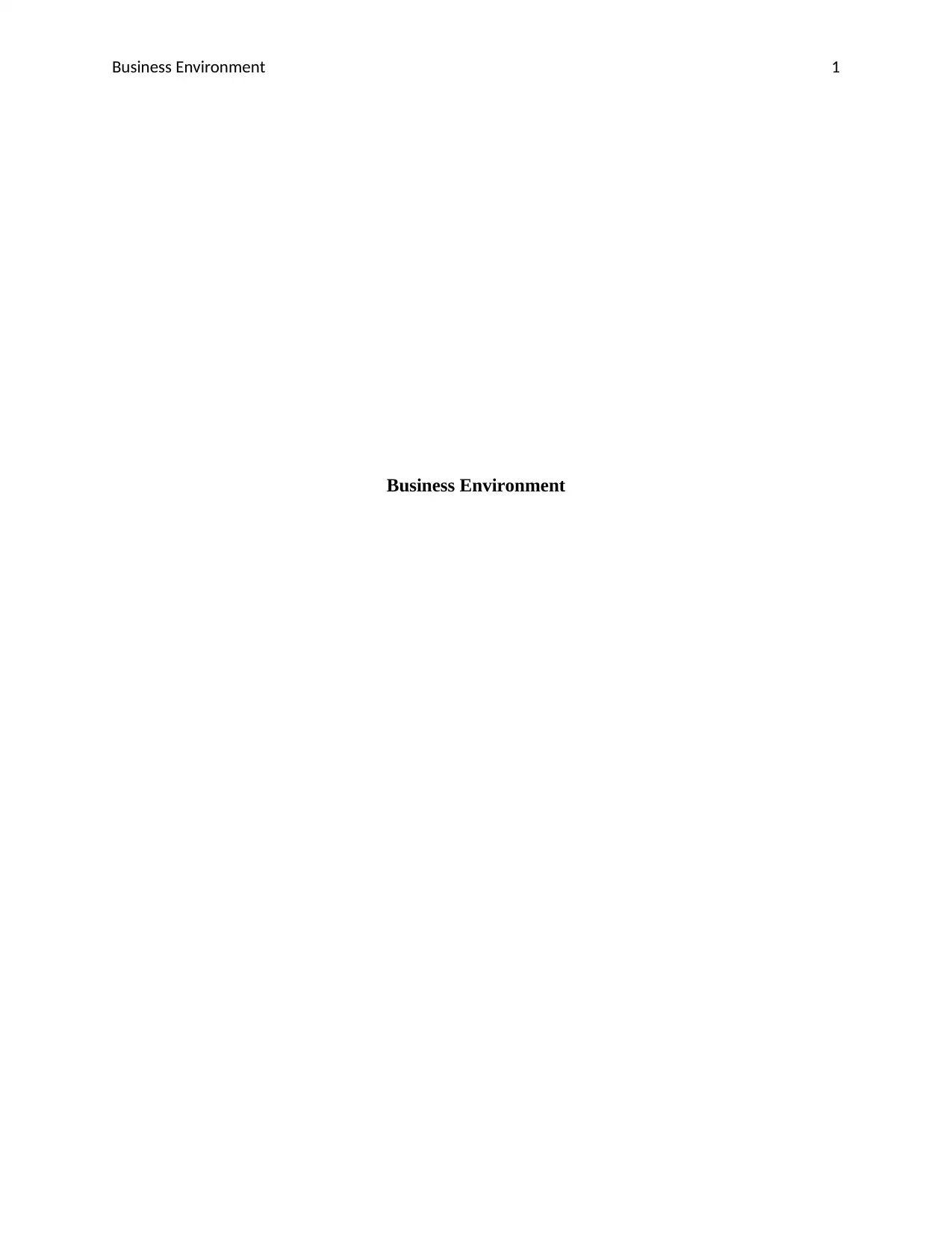
Business Environment 1
Business Environment
Business Environment
Paraphrase This Document
Need a fresh take? Get an instant paraphrase of this document with our AI Paraphraser
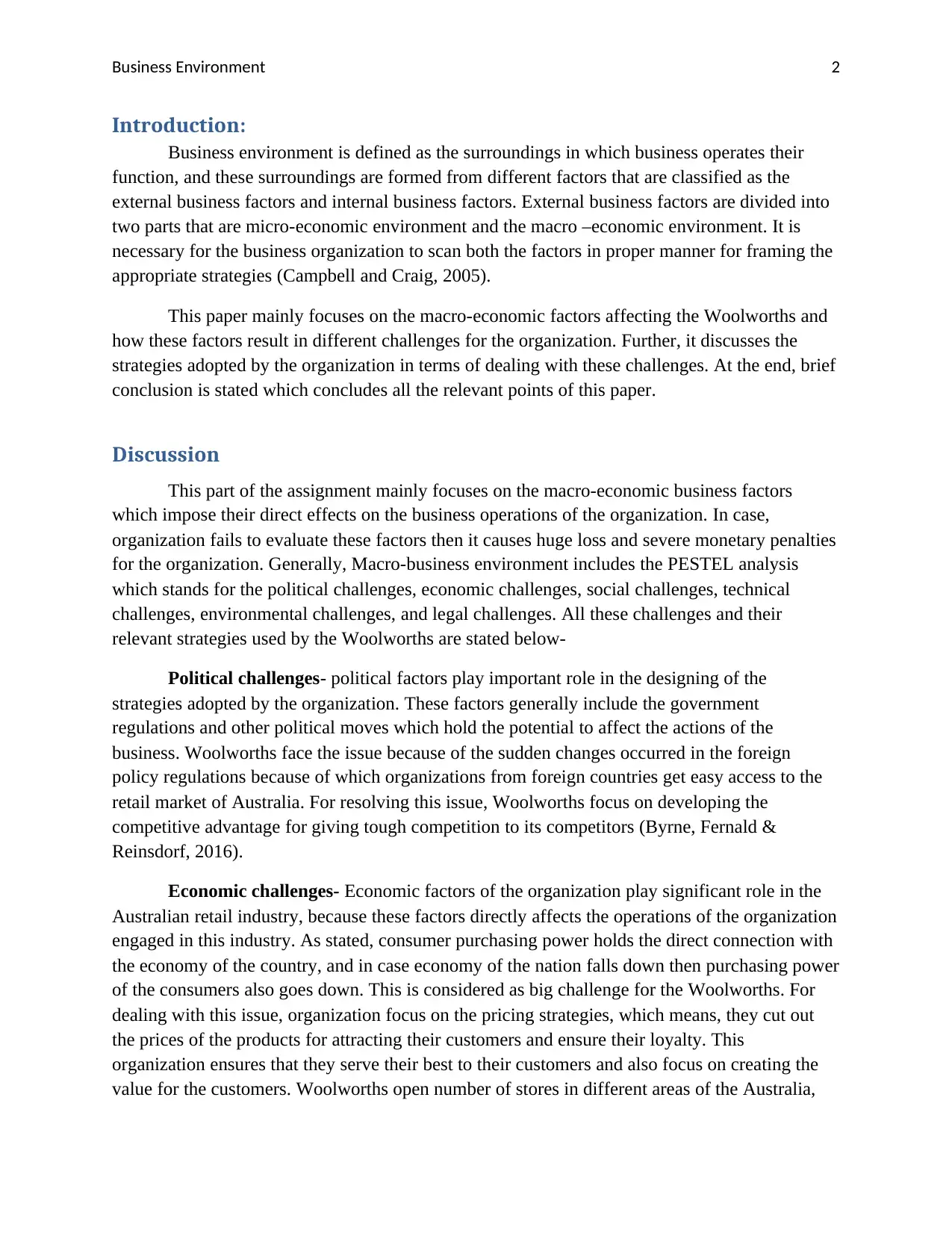
Business Environment 2
Introduction:
Business environment is defined as the surroundings in which business operates their
function, and these surroundings are formed from different factors that are classified as the
external business factors and internal business factors. External business factors are divided into
two parts that are micro-economic environment and the macro –economic environment. It is
necessary for the business organization to scan both the factors in proper manner for framing the
appropriate strategies (Campbell and Craig, 2005).
This paper mainly focuses on the macro-economic factors affecting the Woolworths and
how these factors result in different challenges for the organization. Further, it discusses the
strategies adopted by the organization in terms of dealing with these challenges. At the end, brief
conclusion is stated which concludes all the relevant points of this paper.
Discussion
This part of the assignment mainly focuses on the macro-economic business factors
which impose their direct effects on the business operations of the organization. In case,
organization fails to evaluate these factors then it causes huge loss and severe monetary penalties
for the organization. Generally, Macro-business environment includes the PESTEL analysis
which stands for the political challenges, economic challenges, social challenges, technical
challenges, environmental challenges, and legal challenges. All these challenges and their
relevant strategies used by the Woolworths are stated below-
Political challenges- political factors play important role in the designing of the
strategies adopted by the organization. These factors generally include the government
regulations and other political moves which hold the potential to affect the actions of the
business. Woolworths face the issue because of the sudden changes occurred in the foreign
policy regulations because of which organizations from foreign countries get easy access to the
retail market of Australia. For resolving this issue, Woolworths focus on developing the
competitive advantage for giving tough competition to its competitors (Byrne, Fernald &
Reinsdorf, 2016).
Economic challenges- Economic factors of the organization play significant role in the
Australian retail industry, because these factors directly affects the operations of the organization
engaged in this industry. As stated, consumer purchasing power holds the direct connection with
the economy of the country, and in case economy of the nation falls down then purchasing power
of the consumers also goes down. This is considered as big challenge for the Woolworths. For
dealing with this issue, organization focus on the pricing strategies, which means, they cut out
the prices of the products for attracting their customers and ensure their loyalty. This
organization ensures that they serve their best to their customers and also focus on creating the
value for the customers. Woolworths open number of stores in different areas of the Australia,
Introduction:
Business environment is defined as the surroundings in which business operates their
function, and these surroundings are formed from different factors that are classified as the
external business factors and internal business factors. External business factors are divided into
two parts that are micro-economic environment and the macro –economic environment. It is
necessary for the business organization to scan both the factors in proper manner for framing the
appropriate strategies (Campbell and Craig, 2005).
This paper mainly focuses on the macro-economic factors affecting the Woolworths and
how these factors result in different challenges for the organization. Further, it discusses the
strategies adopted by the organization in terms of dealing with these challenges. At the end, brief
conclusion is stated which concludes all the relevant points of this paper.
Discussion
This part of the assignment mainly focuses on the macro-economic business factors
which impose their direct effects on the business operations of the organization. In case,
organization fails to evaluate these factors then it causes huge loss and severe monetary penalties
for the organization. Generally, Macro-business environment includes the PESTEL analysis
which stands for the political challenges, economic challenges, social challenges, technical
challenges, environmental challenges, and legal challenges. All these challenges and their
relevant strategies used by the Woolworths are stated below-
Political challenges- political factors play important role in the designing of the
strategies adopted by the organization. These factors generally include the government
regulations and other political moves which hold the potential to affect the actions of the
business. Woolworths face the issue because of the sudden changes occurred in the foreign
policy regulations because of which organizations from foreign countries get easy access to the
retail market of Australia. For resolving this issue, Woolworths focus on developing the
competitive advantage for giving tough competition to its competitors (Byrne, Fernald &
Reinsdorf, 2016).
Economic challenges- Economic factors of the organization play significant role in the
Australian retail industry, because these factors directly affects the operations of the organization
engaged in this industry. As stated, consumer purchasing power holds the direct connection with
the economy of the country, and in case economy of the nation falls down then purchasing power
of the consumers also goes down. This is considered as big challenge for the Woolworths. For
dealing with this issue, organization focus on the pricing strategies, which means, they cut out
the prices of the products for attracting their customers and ensure their loyalty. This
organization ensures that they serve their best to their customers and also focus on creating the
value for the customers. Woolworths open number of stores in different areas of the Australia,
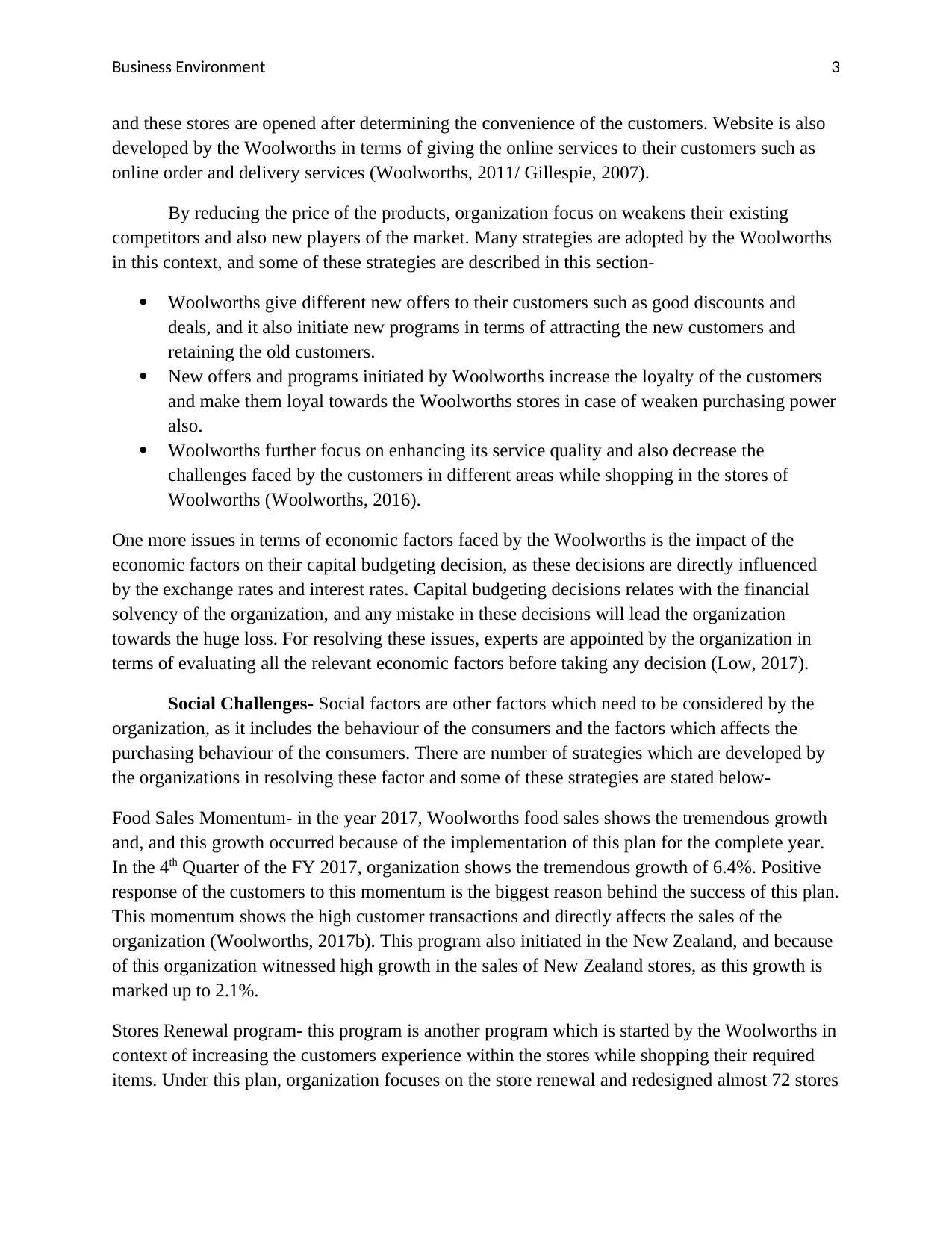
Business Environment 3
and these stores are opened after determining the convenience of the customers. Website is also
developed by the Woolworths in terms of giving the online services to their customers such as
online order and delivery services (Woolworths, 2011/ Gillespie, 2007).
By reducing the price of the products, organization focus on weakens their existing
competitors and also new players of the market. Many strategies are adopted by the Woolworths
in this context, and some of these strategies are described in this section-
Woolworths give different new offers to their customers such as good discounts and
deals, and it also initiate new programs in terms of attracting the new customers and
retaining the old customers.
New offers and programs initiated by Woolworths increase the loyalty of the customers
and make them loyal towards the Woolworths stores in case of weaken purchasing power
also.
Woolworths further focus on enhancing its service quality and also decrease the
challenges faced by the customers in different areas while shopping in the stores of
Woolworths (Woolworths, 2016).
One more issues in terms of economic factors faced by the Woolworths is the impact of the
economic factors on their capital budgeting decision, as these decisions are directly influenced
by the exchange rates and interest rates. Capital budgeting decisions relates with the financial
solvency of the organization, and any mistake in these decisions will lead the organization
towards the huge loss. For resolving these issues, experts are appointed by the organization in
terms of evaluating all the relevant economic factors before taking any decision (Low, 2017).
Social Challenges- Social factors are other factors which need to be considered by the
organization, as it includes the behaviour of the consumers and the factors which affects the
purchasing behaviour of the consumers. There are number of strategies which are developed by
the organizations in resolving these factor and some of these strategies are stated below-
Food Sales Momentum- in the year 2017, Woolworths food sales shows the tremendous growth
and, and this growth occurred because of the implementation of this plan for the complete year.
In the 4th Quarter of the FY 2017, organization shows the tremendous growth of 6.4%. Positive
response of the customers to this momentum is the biggest reason behind the success of this plan.
This momentum shows the high customer transactions and directly affects the sales of the
organization (Woolworths, 2017b). This program also initiated in the New Zealand, and because
of this organization witnessed high growth in the sales of New Zealand stores, as this growth is
marked up to 2.1%.
Stores Renewal program- this program is another program which is started by the Woolworths in
context of increasing the customers experience within the stores while shopping their required
items. Under this plan, organization focuses on the store renewal and redesigned almost 72 stores
and these stores are opened after determining the convenience of the customers. Website is also
developed by the Woolworths in terms of giving the online services to their customers such as
online order and delivery services (Woolworths, 2011/ Gillespie, 2007).
By reducing the price of the products, organization focus on weakens their existing
competitors and also new players of the market. Many strategies are adopted by the Woolworths
in this context, and some of these strategies are described in this section-
Woolworths give different new offers to their customers such as good discounts and
deals, and it also initiate new programs in terms of attracting the new customers and
retaining the old customers.
New offers and programs initiated by Woolworths increase the loyalty of the customers
and make them loyal towards the Woolworths stores in case of weaken purchasing power
also.
Woolworths further focus on enhancing its service quality and also decrease the
challenges faced by the customers in different areas while shopping in the stores of
Woolworths (Woolworths, 2016).
One more issues in terms of economic factors faced by the Woolworths is the impact of the
economic factors on their capital budgeting decision, as these decisions are directly influenced
by the exchange rates and interest rates. Capital budgeting decisions relates with the financial
solvency of the organization, and any mistake in these decisions will lead the organization
towards the huge loss. For resolving these issues, experts are appointed by the organization in
terms of evaluating all the relevant economic factors before taking any decision (Low, 2017).
Social Challenges- Social factors are other factors which need to be considered by the
organization, as it includes the behaviour of the consumers and the factors which affects the
purchasing behaviour of the consumers. There are number of strategies which are developed by
the organizations in resolving these factor and some of these strategies are stated below-
Food Sales Momentum- in the year 2017, Woolworths food sales shows the tremendous growth
and, and this growth occurred because of the implementation of this plan for the complete year.
In the 4th Quarter of the FY 2017, organization shows the tremendous growth of 6.4%. Positive
response of the customers to this momentum is the biggest reason behind the success of this plan.
This momentum shows the high customer transactions and directly affects the sales of the
organization (Woolworths, 2017b). This program also initiated in the New Zealand, and because
of this organization witnessed high growth in the sales of New Zealand stores, as this growth is
marked up to 2.1%.
Stores Renewal program- this program is another program which is started by the Woolworths in
context of increasing the customers experience within the stores while shopping their required
items. Under this plan, organization focuses on the store renewal and redesigned almost 72 stores
⊘ This is a preview!⊘
Do you want full access?
Subscribe today to unlock all pages.

Trusted by 1+ million students worldwide
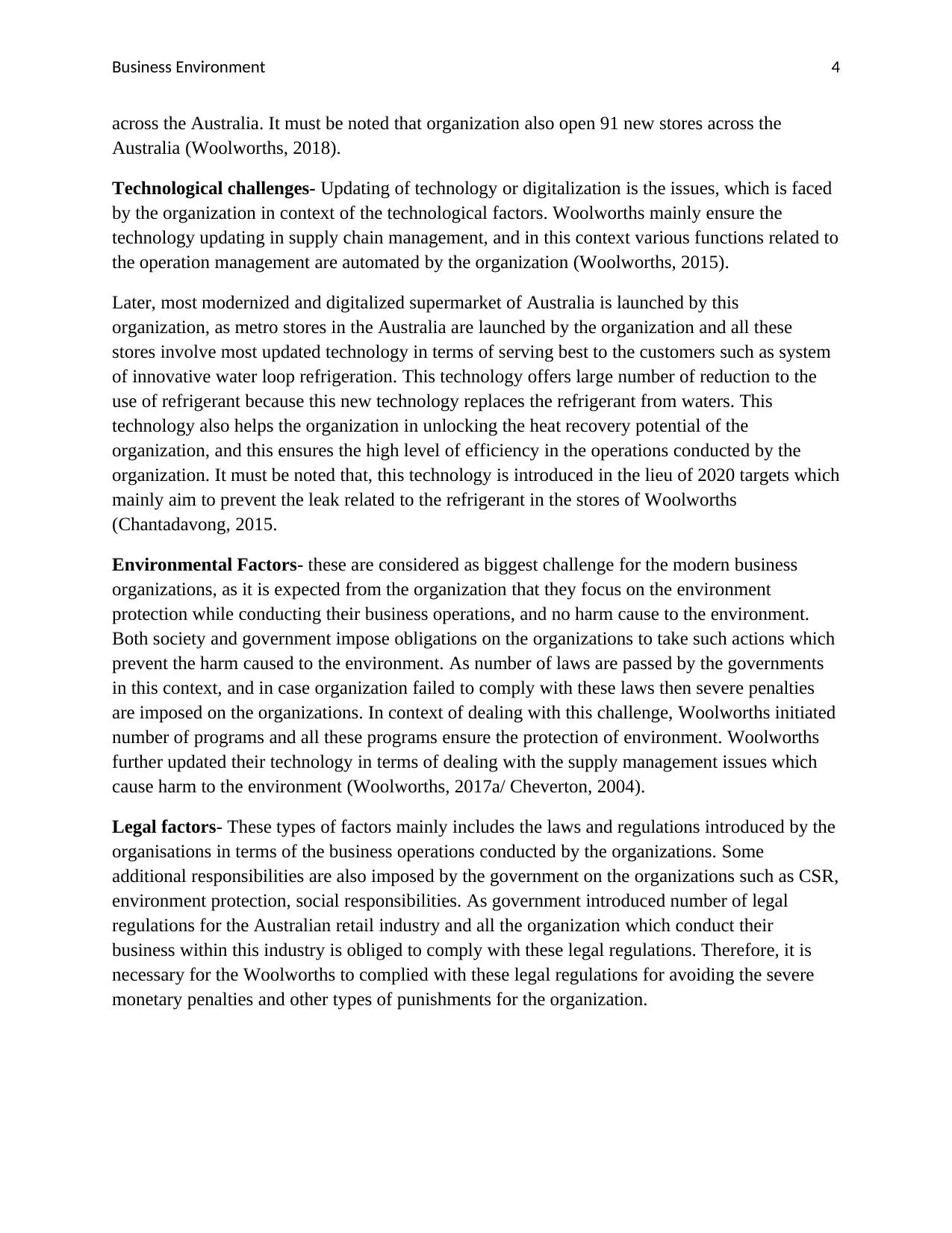
Business Environment 4
across the Australia. It must be noted that organization also open 91 new stores across the
Australia (Woolworths, 2018).
Technological challenges- Updating of technology or digitalization is the issues, which is faced
by the organization in context of the technological factors. Woolworths mainly ensure the
technology updating in supply chain management, and in this context various functions related to
the operation management are automated by the organization (Woolworths, 2015).
Later, most modernized and digitalized supermarket of Australia is launched by this
organization, as metro stores in the Australia are launched by the organization and all these
stores involve most updated technology in terms of serving best to the customers such as system
of innovative water loop refrigeration. This technology offers large number of reduction to the
use of refrigerant because this new technology replaces the refrigerant from waters. This
technology also helps the organization in unlocking the heat recovery potential of the
organization, and this ensures the high level of efficiency in the operations conducted by the
organization. It must be noted that, this technology is introduced in the lieu of 2020 targets which
mainly aim to prevent the leak related to the refrigerant in the stores of Woolworths
(Chantadavong, 2015.
Environmental Factors- these are considered as biggest challenge for the modern business
organizations, as it is expected from the organization that they focus on the environment
protection while conducting their business operations, and no harm cause to the environment.
Both society and government impose obligations on the organizations to take such actions which
prevent the harm caused to the environment. As number of laws are passed by the governments
in this context, and in case organization failed to comply with these laws then severe penalties
are imposed on the organizations. In context of dealing with this challenge, Woolworths initiated
number of programs and all these programs ensure the protection of environment. Woolworths
further updated their technology in terms of dealing with the supply management issues which
cause harm to the environment (Woolworths, 2017a/ Cheverton, 2004).
Legal factors- These types of factors mainly includes the laws and regulations introduced by the
organisations in terms of the business operations conducted by the organizations. Some
additional responsibilities are also imposed by the government on the organizations such as CSR,
environment protection, social responsibilities. As government introduced number of legal
regulations for the Australian retail industry and all the organization which conduct their
business within this industry is obliged to comply with these legal regulations. Therefore, it is
necessary for the Woolworths to complied with these legal regulations for avoiding the severe
monetary penalties and other types of punishments for the organization.
across the Australia. It must be noted that organization also open 91 new stores across the
Australia (Woolworths, 2018).
Technological challenges- Updating of technology or digitalization is the issues, which is faced
by the organization in context of the technological factors. Woolworths mainly ensure the
technology updating in supply chain management, and in this context various functions related to
the operation management are automated by the organization (Woolworths, 2015).
Later, most modernized and digitalized supermarket of Australia is launched by this
organization, as metro stores in the Australia are launched by the organization and all these
stores involve most updated technology in terms of serving best to the customers such as system
of innovative water loop refrigeration. This technology offers large number of reduction to the
use of refrigerant because this new technology replaces the refrigerant from waters. This
technology also helps the organization in unlocking the heat recovery potential of the
organization, and this ensures the high level of efficiency in the operations conducted by the
organization. It must be noted that, this technology is introduced in the lieu of 2020 targets which
mainly aim to prevent the leak related to the refrigerant in the stores of Woolworths
(Chantadavong, 2015.
Environmental Factors- these are considered as biggest challenge for the modern business
organizations, as it is expected from the organization that they focus on the environment
protection while conducting their business operations, and no harm cause to the environment.
Both society and government impose obligations on the organizations to take such actions which
prevent the harm caused to the environment. As number of laws are passed by the governments
in this context, and in case organization failed to comply with these laws then severe penalties
are imposed on the organizations. In context of dealing with this challenge, Woolworths initiated
number of programs and all these programs ensure the protection of environment. Woolworths
further updated their technology in terms of dealing with the supply management issues which
cause harm to the environment (Woolworths, 2017a/ Cheverton, 2004).
Legal factors- These types of factors mainly includes the laws and regulations introduced by the
organisations in terms of the business operations conducted by the organizations. Some
additional responsibilities are also imposed by the government on the organizations such as CSR,
environment protection, social responsibilities. As government introduced number of legal
regulations for the Australian retail industry and all the organization which conduct their
business within this industry is obliged to comply with these legal regulations. Therefore, it is
necessary for the Woolworths to complied with these legal regulations for avoiding the severe
monetary penalties and other types of punishments for the organization.
Paraphrase This Document
Need a fresh take? Get an instant paraphrase of this document with our AI Paraphraser
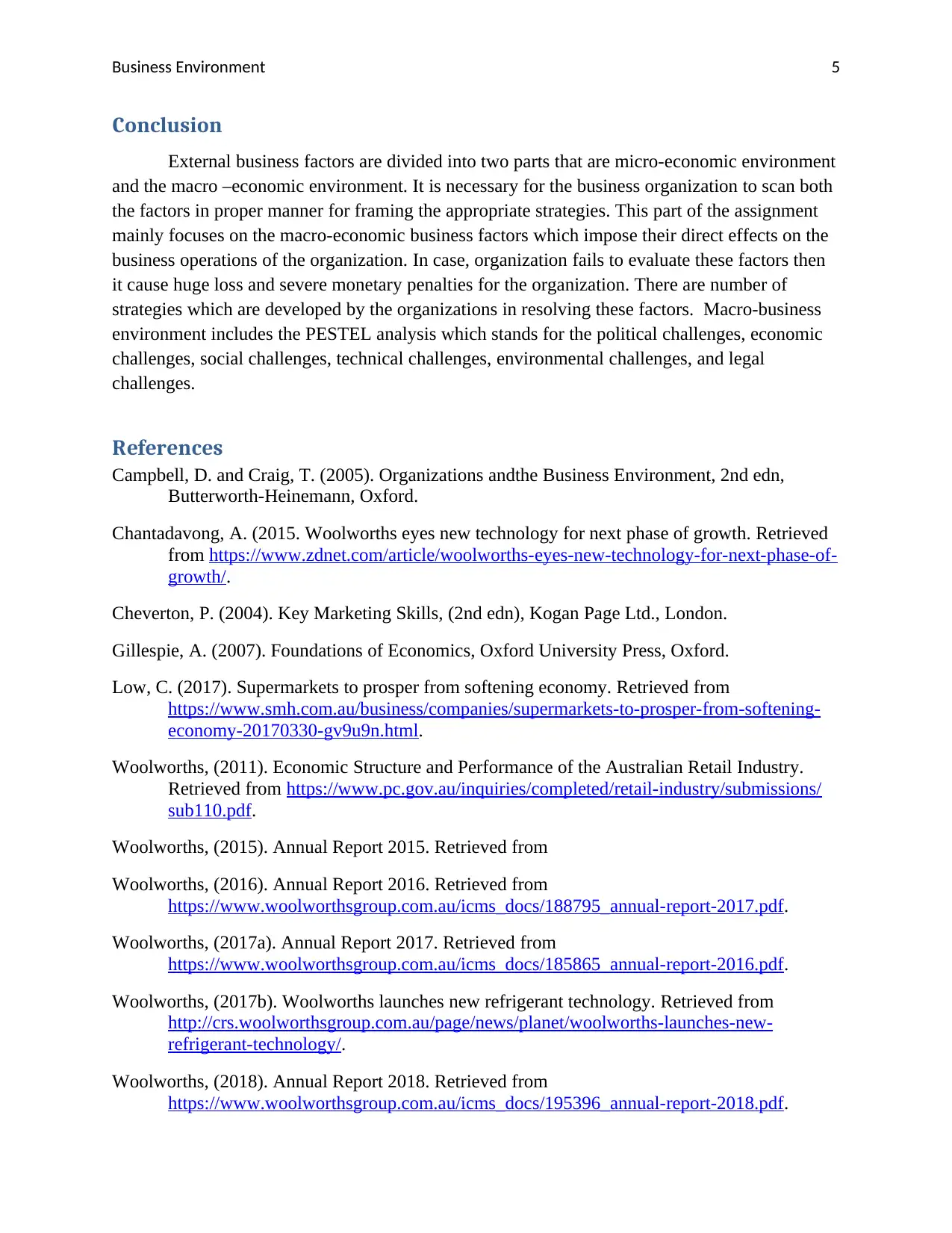
Business Environment 5
Conclusion
External business factors are divided into two parts that are micro-economic environment
and the macro –economic environment. It is necessary for the business organization to scan both
the factors in proper manner for framing the appropriate strategies. This part of the assignment
mainly focuses on the macro-economic business factors which impose their direct effects on the
business operations of the organization. In case, organization fails to evaluate these factors then
it cause huge loss and severe monetary penalties for the organization. There are number of
strategies which are developed by the organizations in resolving these factors. Macro-business
environment includes the PESTEL analysis which stands for the political challenges, economic
challenges, social challenges, technical challenges, environmental challenges, and legal
challenges.
References
Campbell, D. and Craig, T. (2005). Organizations andthe Business Environment, 2nd edn,
Butterworth-Heinemann, Oxford.
Chantadavong, A. (2015. Woolworths eyes new technology for next phase of growth. Retrieved
from https://www.zdnet.com/article/woolworths-eyes-new-technology-for-next-phase-of-
growth/.
Cheverton, P. (2004). Key Marketing Skills, (2nd edn), Kogan Page Ltd., London.
Gillespie, A. (2007). Foundations of Economics, Oxford University Press, Oxford.
Low, C. (2017). Supermarkets to prosper from softening economy. Retrieved from
https://www.smh.com.au/business/companies/supermarkets-to-prosper-from-softening-
economy-20170330-gv9u9n.html.
Woolworths, (2011). Economic Structure and Performance of the Australian Retail Industry.
Retrieved from https://www.pc.gov.au/inquiries/completed/retail-industry/submissions/
sub110.pdf.
Woolworths, (2015). Annual Report 2015. Retrieved from
Woolworths, (2016). Annual Report 2016. Retrieved from
https://www.woolworthsgroup.com.au/icms_docs/188795_annual-report-2017.pdf.
Woolworths, (2017a). Annual Report 2017. Retrieved from
https://www.woolworthsgroup.com.au/icms_docs/185865_annual-report-2016.pdf.
Woolworths, (2017b). Woolworths launches new refrigerant technology. Retrieved from
http://crs.woolworthsgroup.com.au/page/news/planet/woolworths-launches-new-
refrigerant-technology/.
Woolworths, (2018). Annual Report 2018. Retrieved from
https://www.woolworthsgroup.com.au/icms_docs/195396_annual-report-2018.pdf.
Conclusion
External business factors are divided into two parts that are micro-economic environment
and the macro –economic environment. It is necessary for the business organization to scan both
the factors in proper manner for framing the appropriate strategies. This part of the assignment
mainly focuses on the macro-economic business factors which impose their direct effects on the
business operations of the organization. In case, organization fails to evaluate these factors then
it cause huge loss and severe monetary penalties for the organization. There are number of
strategies which are developed by the organizations in resolving these factors. Macro-business
environment includes the PESTEL analysis which stands for the political challenges, economic
challenges, social challenges, technical challenges, environmental challenges, and legal
challenges.
References
Campbell, D. and Craig, T. (2005). Organizations andthe Business Environment, 2nd edn,
Butterworth-Heinemann, Oxford.
Chantadavong, A. (2015. Woolworths eyes new technology for next phase of growth. Retrieved
from https://www.zdnet.com/article/woolworths-eyes-new-technology-for-next-phase-of-
growth/.
Cheverton, P. (2004). Key Marketing Skills, (2nd edn), Kogan Page Ltd., London.
Gillespie, A. (2007). Foundations of Economics, Oxford University Press, Oxford.
Low, C. (2017). Supermarkets to prosper from softening economy. Retrieved from
https://www.smh.com.au/business/companies/supermarkets-to-prosper-from-softening-
economy-20170330-gv9u9n.html.
Woolworths, (2011). Economic Structure and Performance of the Australian Retail Industry.
Retrieved from https://www.pc.gov.au/inquiries/completed/retail-industry/submissions/
sub110.pdf.
Woolworths, (2015). Annual Report 2015. Retrieved from
Woolworths, (2016). Annual Report 2016. Retrieved from
https://www.woolworthsgroup.com.au/icms_docs/188795_annual-report-2017.pdf.
Woolworths, (2017a). Annual Report 2017. Retrieved from
https://www.woolworthsgroup.com.au/icms_docs/185865_annual-report-2016.pdf.
Woolworths, (2017b). Woolworths launches new refrigerant technology. Retrieved from
http://crs.woolworthsgroup.com.au/page/news/planet/woolworths-launches-new-
refrigerant-technology/.
Woolworths, (2018). Annual Report 2018. Retrieved from
https://www.woolworthsgroup.com.au/icms_docs/195396_annual-report-2018.pdf.
1 out of 5
Related Documents
Your All-in-One AI-Powered Toolkit for Academic Success.
+13062052269
info@desklib.com
Available 24*7 on WhatsApp / Email
![[object Object]](/_next/static/media/star-bottom.7253800d.svg)
Unlock your academic potential
Copyright © 2020–2025 A2Z Services. All Rights Reserved. Developed and managed by ZUCOL.





